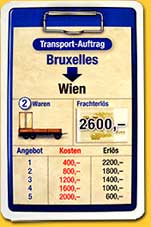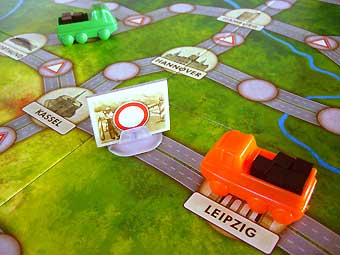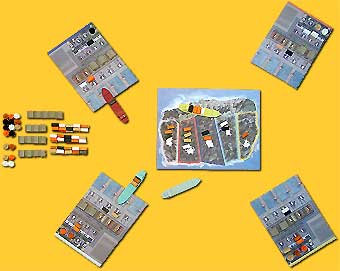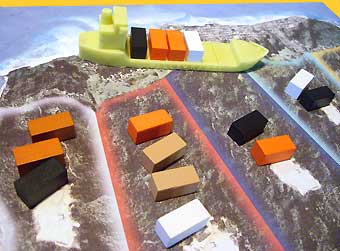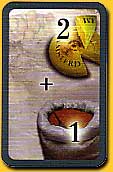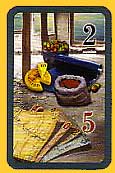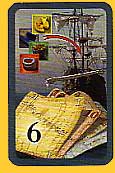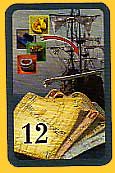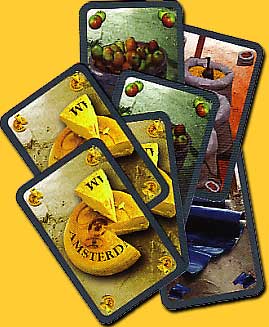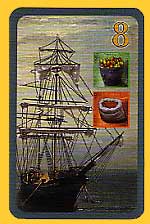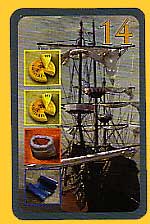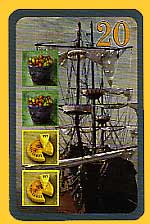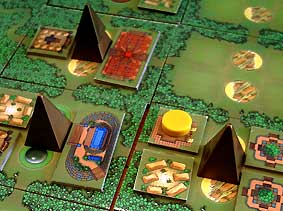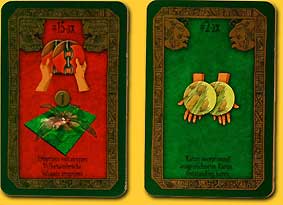| x | |||||||||||||||||||||||||||||||||||||||||||||||||||
 |
Cacao | 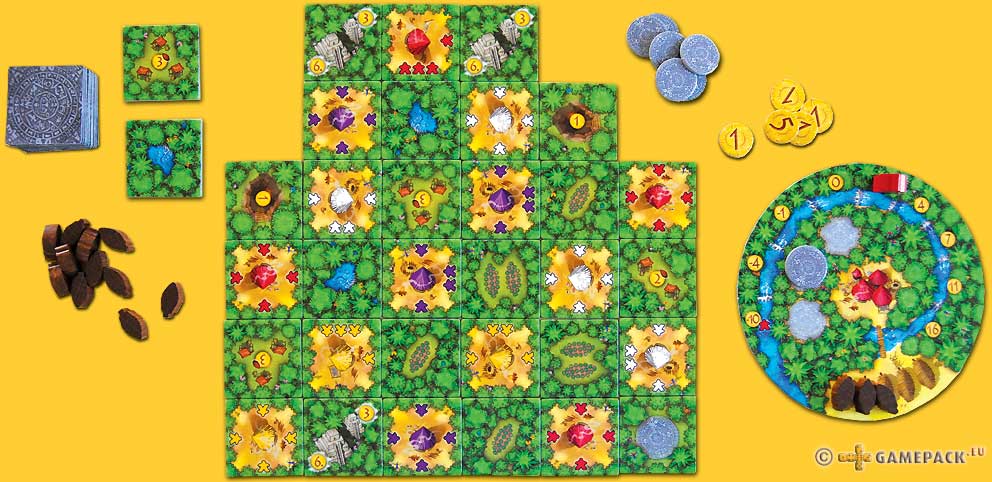 |
|||||||||||||||||||||||||||||||||||||||||||||||||
| 01.10.15 In Cacao we represent tribal chiefs. Of course we have nothing but the best intentions for our people, and what can make a tribe still adhering to the ancient ways more happy than.. money?! Therefore, we grow and trade in cacao. The wealthiest tribe wins the game! At the beginning of the game, a tiny piece of jungle is placed on the table. In his turn, a player adds a tile in his players colour, depicting a hut and four workers. The workers are divided over the four sides of the tile; there are tiles with one worker per side, but also tiles with three workers on one side, one worker on another side, and two sides without workers. By placing a tile a player activates all jungle tiles adjacent to the newly placed workers. He carries out the corresponding action, multiplied by the number of workers on that side of the tile. For example, if he places his tile adjacent to a tile ‘take two cacao’, he takes two cacao per adjacent worker. The tiles are placed in a checkers-motif: alternately a worker tile and a jungle tile. In addition to taking cacao, there are jungle tiles for selling cacao on the market, and gold mines that yield immediate coins, and temples that are scored at the end of the game: 6 gold for the player with the most adjacent workers, 3 gold for the runner-up. The jungle tiles are placed by the active player as soon as a ‘corner’ has been created of two diagonally adjacent worker tiles. If the new jungle tile is placed adjacent to workers, either the active players’ or anybody else’s, these workers are also activated. This way, you can perform actions even when it’s not your turn! But the active player will undoubtedly try his best to place the jungle tiles so that they are advantageous for himself, but not for his opponents. For example, by placing a jungle tile ‘sell cacao’ adjacent to workers of a player who doesn’t own cacao at that moment. With four players there is enough excitement in the jungle to keep the game interesting. With two players, on the contrary, the lack of competition makes the game shallow and even a bit boring. But with full occupancy, Cacao is a smooth and fun game. Barbara van Vugt Cacao, Phil Walker-Harding, AbacusSpiele, 2015 - 2 to 4 players, 8 years and up, 45 minutesxxtop |
|||||||||||||||||||||||||||||||||||||||||||||||||||
| x | |||||||||||||||||||||||||||||||||||||||||||||||||||
 |
Concordia - the expansion boards | 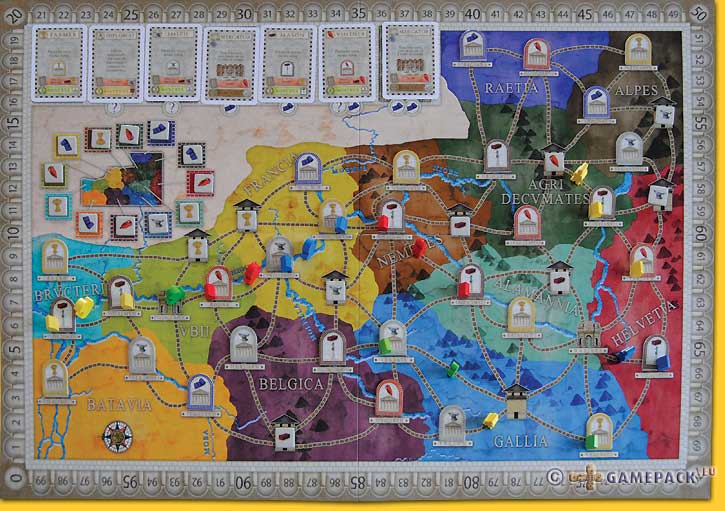 |
|||||||||||||||||||||||||||||||||||||||||||||||||
| 20.01.15 It was not really a surprise to see an extension of Concordia after the success of the game (nominated for the Kennerspiel des Jahres 2014). The Britannia and Germania extension consists of a two-sided game board and 4 pages of explanation, which all fits pretty good in the box of the base game after removal of the cardboard inlay. The explanation only deals with the changes to the base game (which is also explained on this website). For the Britannia side of the boards the changes are rather minimal. Each player starts with a land colonist in London (Londinium) and a sea colonist in Portus Ilius (nowadays Boulogne sur Mer), and sea connections are on this map really by sea, around the Britannia island. This has no effect on the rules or gameplay, but has just a graphical effect. What has effect on the gameplay is the limited number of provinces, which makes this board very good playable for 2 and quite tight for 4-5 players. With the Germania side of the board there are more changes to the base game. The map shows a number of Roman castles on which bonus markers are randomly placed. Whenever a “Tribune” card is played, and a colonist is next to such a castle, the player may take the bonus marker. This is just a single delivery by the castle, since no new bonus marker is placed on it. An additional change is that sea colonists each provide 2 movement points when the Architect is played, so each player now starts with 3 movement points. The limited rule changes do not manage to create a different feeling to the Concordia gameplay; it still is a game of quickly (cheaply) colonizing and the subsequent hoarding of personality cards. This typically a “nice-to-have” extension, with the same (dis)advantages as the base game and mainly of interest for those that play and like Concordia a lot. It still is good game of course, and since we get two variant for a reasonable, this extension still gets a well-deserved plus! Edwin van de Sluis Concordia expansion boards, Walther 'Mac' Gerds, PD Games, 2014 - 2 to 5 players, 12 years and up, 90 minutesxxtop |
|||||||||||||||||||||||||||||||||||||||||||||||||||
| x | |||||||||||||||||||||||||||||||||||||||||||||||||||
 |
Craftsmen | ||||||||||||||||||||||||||||||||||||||||||||||||||
|
02.11.13 Establish a product chain in three years, put raw materials into semi-finished and final products, and ship these to score points. Is it that hard? Well, actually, yes. As first a player needs to acquire different coloured money to be able to buy the production houses that, subsequent, again for money, have to be built. But first of all he needs to place his aide-de-camps and struggle for a first position: send them to the bank, queue to hopefully be the first to be allowed to build a production house, apply for a building plan (but in fact buy a production house) and make sure to also be present at the craftsmen guild in order to produce final products. |
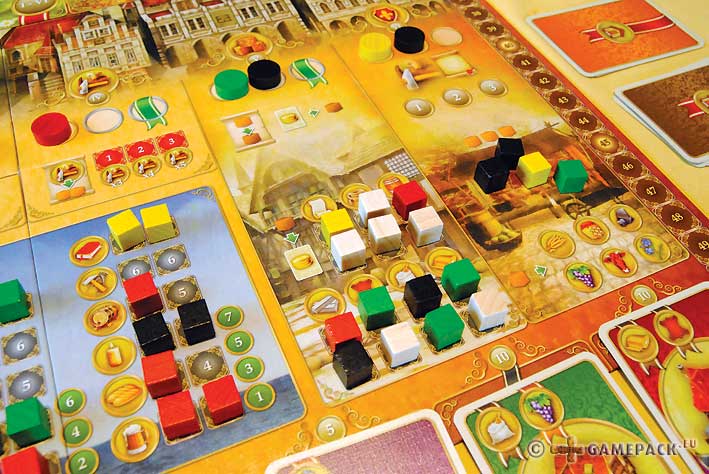 |
||||||||||||||||||||||||||||||||||||||||||||||||||
| x | |||||||||||||||||||||||||||||||||||||||||||||||||||
 |
Augustus |
|
|||||||||||||||||||||||||||||||||||||||||||||||||
|
12.07.13 BINGO! Oh wait, let's start at the beginning. We are representatives of emperor August, and we have the ambition to become consul. To achieve this goal we seek the support of influential senators, and aim to conquer as many provinces as possible. The game consists of a big stack of objective cards depicting either a senator or a province. Each player has three objective cards in front of him. Each card depicts two to six symbols, and there is a cloth bag with 23 tokens with these same symbols. The starting player draws a token and shows this to the others. Each player may now take one of his six legions and place it on a corresponding symbol on one of his three objective cards. Then, the next token is drawn, until... BINGO! Exactly: until one of the players has covered all the symbols on one of his cards. But instead of 'bingo' he cries 'Avé Caesar'. And he is not awarded with a crocheted tea cosy or a bottle of home-brewed cherry brandy, but he simply transfers his card to his 'fulfilled objectives' area and draws a substitute from the five open available objectives. Some cards have an effect that has to be resolved immediately, such as taking an additional objective card, rearranging all his legions, or removing legions from opponent's objective cards. Additionally, bonuses are awarded for fulfilling objective cards with specific provinces or senators. The first player to fulfil seven objective cards triggers the end of the game: after completion of his turn, all points are scored. Augustus is more than just Bingo with a twist. For starters, one can choose his objective cards and therefore willingly commits himself to a card with many or few symbols, rare or common symbols, a card with a desired additional action, or one that can yield the player a bonus. But it is not a truly strategic game: you can be unlucky with respect to the symbols drawn from the bag, or regarding the available objectives when it's your turn to choose one. With four or more players an ailment pops up which is reminiscent of old-fashioned Bingo: with each 'Avé Caesar' the attention slackens, and when there are three players with a full card at the same time (which is not a rare event!), the game comes to a full stop. But with a game time of hardly 30 minutes this doesn't have to be a big problem. The advantage of the familiar gameplay is that the rules are easy to understand, and the game is therefore suitable for all players: more and less experienced alike. Definitely a featherweight, but very good in its class! Barbara van Vugt |
|||||||||||||||||||||||||||||||||||||||||||||||||||
| x | |||||||||||||||||||||||||||||||||||||||||||||||||||
 |
Bora Bora | ||||||||||||||||||||||||||||||||||||||||||||||||||
|
05.02.13 Dice are the thing these years! And Feld uses them this year too! The setting is tropical; players deal with populating huts and offering to the gods, the men increase their status with tattoos, and the women collect shells to buy jewelry with. What a peaceful world! |
 |
||||||||||||||||||||||||||||||||||||||||||||||||||
| x | |||||||||||||||||||||||||||||||||||||||||||||||||||
 |
Blockade Runner | ||||||||||||||||||||||||||||||||||||||||||||||||||
|
11.08.12 A piece of the East Coast of the United States surrounded by a large pond of water, a handful of coastal and inland cities and some foreign ports; this is the map on which ‘Blockade Runner’ is played. It is 1861, and the war between North and South is in full swing. The Southern States need war goods that can only be obtained through foreign ports, while cashing their cotton and tobacco there. The Northerners meanwhile lurk, trying to block ports or raid somewhere along the coast, possibly inflicting losses to the South. Each of the players who all represent the Confederates receive a few ships and some money, and pick a harbour for each of their ships . The Union side is abstract and the jammer it is, is effectuated with all kinds of tables, cards and dice. Jointly supplied war goods reduce the number of ports terrorized; another table closes one or more ports after a die roll, the Northern blockade is permanently effective there. |
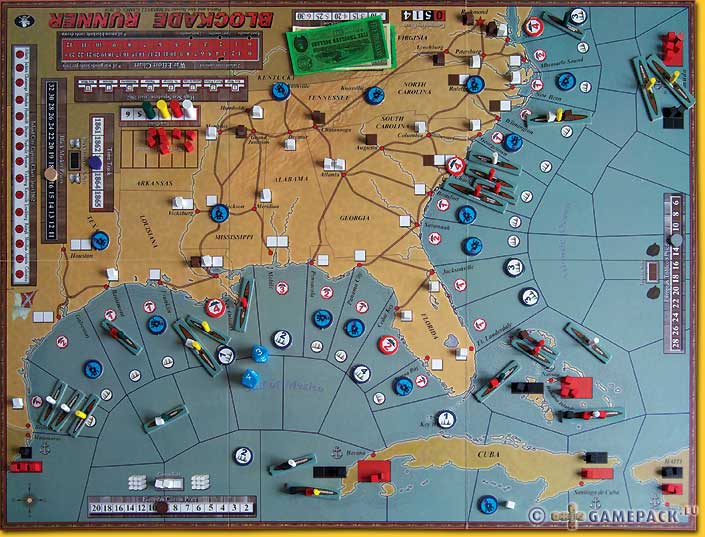
|
||||||||||||||||||||||||||||||||||||||||||||||||||
| x | |||||||||||||||||||||||||||||||||||||||||||||||||||
 |
Artefakt | ||||||||||||||||||||||||||||||||||||||||||||||||||
| 20.08.10 Ten numbered locations that are laid out randomly in a circle act as a game board. Three treasure hunters per player enter the game per dice roll, but from then on are moved with cards simultaneously chosen by each player. Each round four treasure parts are again through a dice roll, placed at various locations and players try to get their treasure hunters there to be the only one or have a majority. Each location has a specific feature that the player may use such as taking a treasure part from the general supply, or taking one from an other player, or move a treasure hunter of an other player, and, in effect, achieving a majority on a location and taking the treasures there. A player wins if he manages to be the first to collect a complete treasure, consisting of four different parts. Becauses of the various features on the locations the game gets lifted just enough above average to become interesting; apart from guessing what an other player will do there still is some room for tactical considerations. Only the rule that ends the game immediately after one player has collected a complete treasure feels a bit rigid -other players in that last round should also get a chance in completing their treasures. 'Artefakt' is an easy and open family game with familiar elements, a low entry level and a short game length. Although nothing really shocking new, games like this also have a right to exist! Artefakt, Michael Palm & Lukas Zach, Winning Moves, 2011 - 2 to 4 players, 10 years and up, 30 minutesxxtopxxx |
|
||||||||||||||||||||||||||||||||||||||||||||||||||
| x | |||||||||||||||||||||||||||||||||||||||||||||||||||
 |
Basilica | ||||||||||||||||||||||||||||||||||||||||||||||||||
| 20.05.11 Exam question: how much manpower does it take to build a basilica? Free answer: two players, man or woman, no more, no less. That these two are constantly hindering each other is less important but in fact increases the tension. Each turn a player may perform three the same or different actions: take one of three coloured build tiles from the display and place it on the grid of the basilica, place a cube on a justly laid build tile, or take one of the three displayed action tiles and perform its action. The build tiles may be placed within the grid of five tiles wide, where it is wise to create a large area in any one colour and be the one who has the moist cubes placed in it. Three times in the game there is a score. This all is quite straightforward, but the action tiles spice up the game. With these a cube can be upgraded, for instance, so it counts as two in a score when determining majorities, or a tile allows a player to place an additional cube on an empty tile of his choice. With many of the action tiles the other player also may perform a similar action but has to pay with it with a coin that goes to the other player. And each player only has one coin, so the question is: when to deploy? When a player owns both coins the other player cannot react when one of the action tiles is played; but the owning player should ask himself how long to sit on both coins as he also is not able to react on an action tile of the other player. Additional consideration in the game is that an empty spot after taking a build tile immediately is filled by flipping the overlying action tile -all tiles have a build side and an action side. By taking the build tile, a player can deny a nasty action tile to his opponent. After each score the cubes are removed from the board, and the first two rows of the basilica are, not quite in line with the theme of building a basilica, removed. A king pawn is moved one space forward each time when a build tile with a crown on it is built. This pawn uses the score track, and when it reaches the end the game ends. The game also ends when the stack of tiles is depleted a second time. 'Basilica' is a simple tile laying game where the two players constantly are hindering each other: deliberately place a different colour tile adjacent to the area in which the opponent has a cube so its growth is made more complicated; or remove a tile with an action tile, thereby reducing the size of the area. Of course each player is restricted in his possibilities, and of course it is a fairly random game with not too much depth. But occasionally, with two players? Sometimes you're just happy with something small. Basilica, Lukasz M. Pogoda, Rebel, 2010 - 2 players, 10 years and up, 45 minutesxxtop |
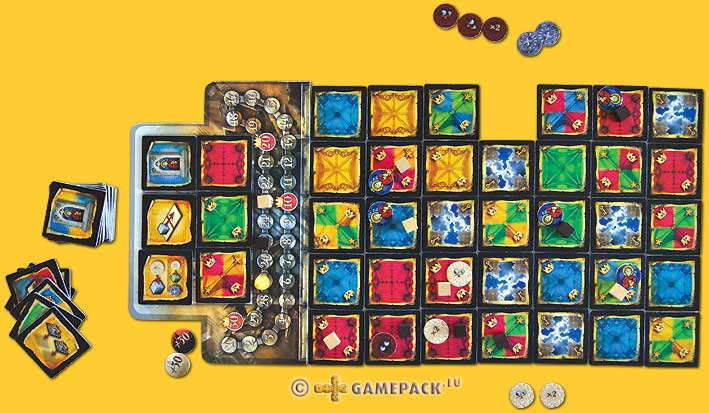 |
||||||||||||||||||||||||||||||||||||||||||||||||||
| x | |||||||||||||||||||||||||||||||||||||||||||||||||||
 |
Campos | ||||||||||||||||||||||||||||||||||||||||||||||||||
| 30.01.11 In 'Campos' players one by one place their playing pieces that consist of three connected coloured hexagons. They weigh their chances when to score and play one of their score cards. These come all in the form 'when a chain of colour A is larger than the largest chain of colour B, you score the amount of the size of colour C'. Because players only have a stock of two tiles that are placed face up, possibilities are limited, but hey, all players play with this handicap. Keeping a good eye on what other players build on, try to limit their possibilities and strike when you think it will be most favorable to you is the motto. Unfortunately the dealt score cards sometimes deal with the same colours or have a conflicting condition, and the construction of the coloured chains not always develop as one would like to see it. Each turn the stock of two pieces have to be played; the other possibility is that a player only places one, but then he has to play a score cards as well. When a player runs out of score cards the first phase of the game ends. Each player gets additional score cards (players still with cards in their hand keep these), and the second phase starts. The alteration is that now two pieces have to be removed from the table, or just one, with playing a score card. This way the chains get shorter with the game ending when the last piece has been removed. Points are marked on a very awkward little scoring board, that is a minus point. The playing pieces however are made of a robust type of plastic and have a pleasant heavy feeling, and that is a plus. Further the game is a light weight in the abstract category and certainly not very original. But it doesn't all have to be geniuses. 'Campos' therefore gets a plus. Campos, Pietro Vozzolo, Huch! & Friends, 2010 - 2 to 4 players, 8 years and up, 30 minutesxxtop |
|
||||||||||||||||||||||||||||||||||||||||||||||||||
| x | |||||||||||||||||||||||||||||||||||||||||||||||||||
 |
Caravelas | ||||||||||||||||||||||||||||||||||||||||||||||||||
| 27.01.11 Sail the seas and in the meanwhile build a cloister, that is what we get to do in 'Caravelas'. Various harbours stock goods that when delivered at our homebase Lisboa score points. Turn in a specific coloured good and you may build part of the cloister, scoring double the points of the good turned in so why anyone wouldn't do it is a mystery. A player may choose which route he takes and make use of favorable winds, but soon it is clear to any player that there really is only one efficient route that leads to the East and back. There are eight different goods that basically all do the same thing: score points; there is no additional layer. Two of these goods, worth double points, only can be collected when the fleet has been upgraded by turning in three different coloured goods. When the last of five parts of the cloister has been claimed, the game ends. At the start of the game each player gets harbour cards which score if he manages to be the first to reach that specific harbour. But the starting player is able to cover almost the whole West coast of Africa, whether he has the cards of the harbours or not, thereby denying other players these points. 'Caravelas' breaths the atmosphere of a game from the seventies; it all is very one dimensional. Even 'Öl für uns Alle'/'Oil for the World' (1976) has, with all its shortcomings, more depth. Seventyfive minutes stupidly sailing back and forth isn't very captivating. Lastly, the age from which the game can be played is set way too low. To justly interpret the navigation cards, one has to be a bit older than eight years. Caravelas, Gil d'Orey, MesaBoardGames, 2010, - 2 to 4 players, 8 years and up, 75 minutesxxtop |
|
||||||||||||||||||||||||||||||||||||||||||||||||||
| x | |||||||||||||||||||||||||||||||||||||||||||||||||||
 |
Asara | ||||||||||||||||||||||||||||||||||||||||||||||||||
| 11.09.10 We travel to the legendary land of Asara where the inhabitants are known to compete with each other by erecting the highest and most beautiful towers. We quickly adopt this local obsession, and before long we also pull our weight in the tower construction business. We have four years to outdo our fellow travelers. At the beginning of each year the players receive seven cards in five different colours that can be used to obtain tower elements. Every turn a player plays one or two of his cards. In each of four different sections there is a display of tower elements in different colours; two sections contain middle parts, and the other two sections foundations and tops. To obtain a tower element a player places one of his cards in the section of his choice and takes a tower element from the display. The colour of the tower determines the costs. All other players that want to purchase a tower element in the same section this year have to follow suit by playing a card of the same colour, or they can play two cards as a wildcard. The tower elements are stored behind the players' screen; in the sector in the center of the board players can place a card if they want to erect a tower with their accumulated tower elements. They can choose to pay 1 to 7 coins and subsequently build the same number of elements. A player erects a tower using tower elements of the same colour, starting with the foundation, then one or more middle elements, completed by a top. Multiple towers may be erected per turn, as long as they are built to completion in that same turn. Later in the game, existing towers may be expanded with additional middle parts, which also can be important for the final scoring phase. When building a tower, a player immediately receives victory points equal to the number of tower elements just erected. A year ends when all players have used up all their cards. At the end of the year players score one point for each tower, one point per element with a gold decoration, and one point for the current starting player. The displays are restocked with tower elements, all cards from the sections are removed, players receive seven new cards and 20 coins, and a new year begins. After four years there is an additional final scoring phase: points are awarded for the highest tower of each colour, the overall highest tower, and the largest number of towers. The player with the highest score can go home proudly twittering, and may add this achievement to his Facebook and Wiki. 'Asara' is a lighthearted family game that can be taken to a higher level using the already included expansion, but nonetheless remains a bit shallow. That is not necessarily a bad thing, but this game lacks the cunningness of some of the other Kramers & Kieslings. 'Asara' has little room for strategy; players are very dependent on the cards they receive per round. The only excitement comes into play when a player wants to purchase an additional tower element before going to the central sector to build a tower; he thereby takes the risk that another player builds before he does, and thus determines the colour of the card that all other players from now on have to play in that sector. Asara, Wolfgang Kramer & Michael Kiesling, Ravensburger, 2010 - 2 to 4 players, 9 years and up, 45-60 minutesxxtopxxx |
|
||||||||||||||||||||||||||||||||||||||||||||||||||
| x | |||||||||||||||||||||||||||||||||||||||||||||||||||
 |
Charly | ||||||||||||||||||||||||||||||||||||||||||||||||||
| 12.06.10 We are terribly popular, and we want to celebrate this. All our Hyves friends, Facebook fans and Twitter followers have been invited. If only they are animals that is, we wanted to make this little restriction. We are faced with some problems concerning logistics though, because the hype around the by us organised and ofcourse terrific party causes many animals to come, in fact more than expected, and so it turns out that we have a shortage of food. We can throw in the occasional honey drop as a sop, but when these are depleted the party is over and the player who has serviced his guests the best has won. Each round every player is dealt seven cards on which one to three animals of one kind are depicted. Also each player gets a food card on which the food for one type of animal is depicted, from four to eight portions. Depending on the amount of players one to three food cards are placed face open; these provide some grip as together with the one food card on his hand a player at least now is clear how much food and of which type is available. What other players hold in their hand may become clear during play. In a turn, a player can improve his hand, for instance by discarding a card with three dogs when the player has no bones food card in his hand and there is none in the display. He can take a blind card from the stack, or take the previous discarded animal card - the one before he discarded his own card. This continues until a player decides dinner is ready. He calls: 'Mahlzeit!' (enjoy your meal), and first all players place their food card face up in the display. Now each player may place, one by one, an animal card with the food cards, but it must match so mice go with cheese, and dogs with bones. Oh, and Charly the pig and his friends eat anything. Food cards supply as many animals as food depicted. If a player cannot feed anymore, he must pass. When every player has passed, all not feeded animals get a honey drop . Each player starts with fifteen drops; when a player at the end of a round is out of drops the game ends and the player with the most honey drops left has won. 'Charly has a pleasant short game length and this surely is because it is a light card game in the category 'Time Left Before/After The Serious Game Work'. The game takes a maximum of twenty minutes and this sees that it always can be played somewhere in between. This and because of its simpleness the game will also be played with guests that otherwise would never play a game. The included and superfluous feeding bowl has to justify the large box, but without it a rubber band around the whole animal caboodle takes it handily at your holiday destination! Charly, Inon Kohn, AbacusSpiele, 2010 - 2 to 6 players, 6 years and up, 20 minutesxxtop |
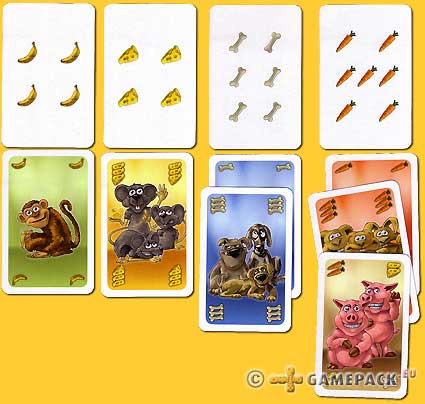 |
||||||||||||||||||||||||||||||||||||||||||||||||||
| x | |||||||||||||||||||||||||||||||||||||||||||||||||||
 |
Carson City | ||||||||||||||||||||||||||||||||||||||||||||||||||
|
The Wild West is a relatively underused theme in board games. Perhaps that players rather play 17th century nobles or or help with building Greek temples or medieval French cities? Come how it may, in this game we are fortune seeking cowboys. The board displays a track on which several action can be chosen and a grid with parcels on which buildings can be built. The intention is to claim country and then subsequently build on it. To do this each player controls a number of cowboys, which he can place on the board during a round. Each turn players one after another place their cowboys on an action; most squares allow only one cowboy to perform the action. When all players have finished placing their cowboys, the actions are carried out in order. |
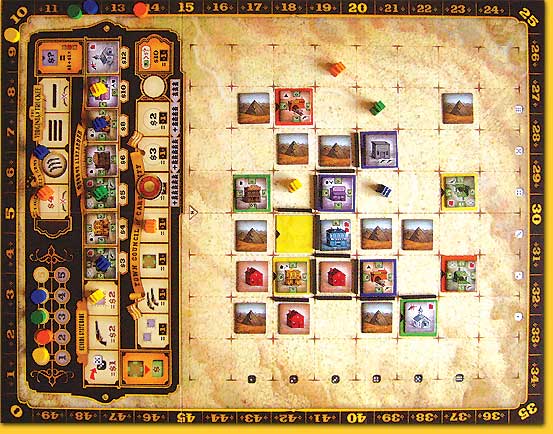 |
||||||||||||||||||||||||||||||||||||||||||||||||||
| x | |||||||||||||||||||||||||||||||||||||||||||||||||||
 |
A la Carte | ||||||||||||||||||||||||||||||||||||||||||||||||||
| 18.11.09 We are a disciplined group of players, we are. When someone has prepared the rules for a new game and is explaining it to us, we listen very carefully and without interruption - questions to be asked only at the end of the explanation. So when we were seated for 'A la Carte', there was no exception to this unwritten rule; we were listening with care and without diversion... until the adding of ingredients was explained. There was a short moment of anarchy, when all three of the players grabbed a bottle to experiment with the dose of the ingredients. After this, feeling a bit ashamed of our behaviour, we were carefully listening again to the explanation... until the preparation of the crepes was handled! Again we lost control as we grabbed the little casseroles to try to bake a nice crepe, flipping it in the air and trying to grab it with the casserole as it came down on its backside! Happily the explanation was near its end, as the interpreter almost lost her temper! Okay, we could start with the game for real now! In the game players try to claim victory by acquiring three cooking stars in preparing recipes. To claim a star, a dish must be prepared with the right amount of ingredients, and with the hob on the right temperature. Players choose from a window of recipes the one they want to prepare, and put it in their casserole. On each recipe the required ingredients are stated, as well as the temperature on the hob to prepare it with. A player may conduct three actions, represented by three card board ladles, and passes one of them to his left neighbour when performing an action. To turn the gas higher, a player has to throw a die; sometimes all other players will have to increase their temperature too, even when it is not to their advantage. An other action is putting the dish on flavor. Pepper, red pepper, lemon and oregano can be added from one of the tiny bottles; the dishes require one or two of an ingredient. Unluckily the bottles of ingredients also contain salt and when they are added, claiming a cooking star is impossible. No player will want to add salt or too much of an ingredient, but because the ingredients are irregularly shaped, players have no control in how much they can add to their dish. Sometimes one ingredient comes out of the bottle, sometimes two, but when three are added the dish is spoiled and must be thrown away. There is the more than the occasional instance where a player turns his bottle and it stays uncomfortable silent: no single ingredient has fallen out of the bottle! When a dish is spoiled a player must try his luck with a new recipe. This could be the preparing of a crepe: no ingredients are needed, the only thing a player has to do is throw the cardboard recipe from his casserole in the air, trying to flip it and catching it with the casserole when it comes down; the ready crepe earns five points that can become important when at game end no player has succeeded in acquiring three stars and in this case the finished dishes score points. Special coffee breaks allow a player to villainously season and spoil an other players dish, of course with ingredients he does not need in the first place! It is a while since we had so much fun when playing a game; 'A la Carte' is undivided pleasure. It looks terrific; the rules are simple and clear, and the theme fits perfectly well. We don't mind if 'A la Carte' would end high on the Nominierungsliste as a candidate for the Spiel des Jahres! A la Carte, Karl-Heinz Schmiel, Moskito Spiele / Heidelberger Verlag, 2009 - 3 to 4 players, 8 years and up, no time indication (approx. 50 minutes)xxtop |
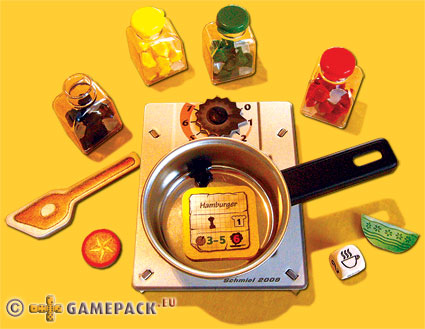 |
||||||||||||||||||||||||||||||||||||||||||||||||||
| x | |||||||||||||||||||||||||||||||||||||||||||||||||||
 |
Alea Iacta Est | ||||||||||||||||||||||||||||||||||||||||||||||||||
| 12.05.09 Boys, we're gonna have a good laugh! Look at that prolapsed 'A' of the title! Many comic movie started this way, with a shot at one or the other logo, at the owner's shop or on the entry lane to a ranch, whereby zooming in the letter promptly got detached. Hilarious! As if your pants slip off! Yes, this is going to be fun; hold on to it, this is going to be a wild ride! The brand Alea, put in the market for the strategic player, celebrates its tenth year of existance, and it seems as if they have thrown in the towel because with this game they seem to act as tame sheep instead of the wolves as which they entered the market. A game with dice, not just a few, as each player gets eight of them in his player colour. This does not matter at all, because we do want to play Yahzee once again! Alea does not quite rests assured, because the dice game comes in a Roman setting in order to give the game at least some cachet, but it has undeniable Yahzee characteristics: form a street here, build a nice row there, and the sludge, well, we throw it in the latrines! All comes down to house several senators and their wives in varying fitting provinces. These can be collected via the Forum Romanum; the provinces need a lucky same-eye row in the Castrum, while the Templum delivers straight victory points. Finally, in the Senatus the bonus tiles get a chance, which, at the end of the game, may push the victory points a bit more towards victory. Players with bad luck can get chits in the Latrina, that can be used for a reroll in later turns. The atmosphere fits, the cartoonesque illustrations are just what the game needs to give it the right airiness. As said: who does not want to throw dice once in a while? The game ranks itself as a 2 on a difficulty scale of 10, but for the rules, a booklet of eight tight printed pages, an exception has to be made; it is just too much text for a dice game! Likewise, for the Senatus bonus cards each player has to refer to the separate thin survey paper sheet in order to get the sometimes vague icons explained in plain text. Erhm, but it is a nice game, it is! Alea Iacta Est, Jeffrey D. Allers & Bernd Eisenstein, Alea / Ravensburger, 2009 - 2 to 5 players, 9 years and up, approx. 60 minutesxxtop |
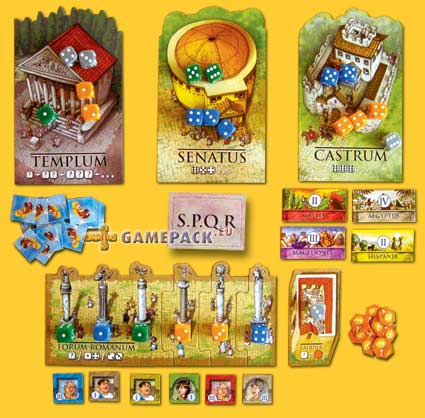 |
||||||||||||||||||||||||||||||||||||||||||||||||||
| x | |||||||||||||||||||||||||||||||||||||||||||||||||||
 |
Bürger, Baumeister & Co. | ||||||||||||||||||||||||||||||||||||||||||||||||||
| 06.03.09 ‘Bürger, Baumeister & Co.’ has been developed by order of the Frankfurter company ‘Saalbau’ in honor of their 150 years of existence. So what has ‘Saalbau’ been doing all these years? Well, building! As the name already implies, they build meeting halls to let for concerts, theater performances, balls, and exhibitions. In the game the two to four players are also going to build, but this must be taken with a pound of salt as the building merely comes down to placing coloured discs on a city map. With this amount of salt involved, is the game still digestable? Let’s zoom in on the details... We see an old city map that has different coloured areas. Each of these areas consists of three to five quarters that can hold one disc. These discs come in five colours with three different symbols: houses, mansions, and parcs, and have a value of two or three. At the start of the game each of the players has drawn three discs from a cloth bag. In a turn a player places one of these three in a quarter with the same colour as the disc. The player scores for the value on the disc, and for each disc with the same symbol in other quarters of that area. Some quarters additionally earn a gold coin, others give a plus two on the score or have no bonus at all. The money is important for two reasons: at the end of a turn a player refills his hand to three discs by taking a disc from a wheel that has a general token on one of the positions. The disc at this position can be taken for free, but the others cost one or two gold. But money is rare, and also needed for building a crane. The crane is put in an area after a player has placed a disc; he pays two money for it and either scores double or adds four to his score, depending on the area he has built the crane in. A player who manages to score twenty plus with this action has done well. At the end of a turn, the token at the wheel is placed to its next position and the wheel is refilled with a disc from the bag. When bag is empty, the game ends immediately. Players may add to their score the value of any same coloured discs; the player with the highest score has won. The 'Night Watch’ by Rembrandt van Rijn also was made by order, and it still attracts thousands of people every day. The game cannot compare to the level of a Night Watch, for this its presentation alone is a bit too dull – but also it has a different target group: that of the occasional and inexperienced player; therefore the rules and gameplay have been kept simple. Yet it is a nice game with a low entry level that still has interesting considerations to make. Quickly explained, swift gameplay, not too difficult or too long, and still enjoyable; when you are able to develop such games for a principle and the aimed target group, you show that you understood the assignment and how a game works, one that hopefully attracts more people to the pleasure of gaming! Bürger, Baumeister & Co., Michael Schacht, Abacusspiele, 2009 - 2 to 4 players, 8 years and up, 45 minutesxxtopxxx |
|
||||||||||||||||||||||||||||||||||||||||||||||||||
| x | |||||||||||||||||||||||||||||||||||||||||||||||||||
 |
Byzanz | ||||||||||||||||||||||||||||||||||||||||||||||||||
| 14.12.08 Forget about the oriental setting, or the role of sympathetic Musselman we apparently have to take: dependent on the amount of players in this card game a different amount of rounds are played for cards. These cards bring points, just as many as the number on it. Not all cards score: players have to discard a set of three cards of the same colour, where only the highest number in the set is kept for scoring at the end of the game. At the beginning of a round an offer of cards is laid out; players bid with the cards they have in their hand, and place their bid on the table. This right away causes a dilemma, as a player would want to keep the higher numbered cards in his hand to try to make a set of it for scoring, but he also wants to bid as high as possible if the cards in the offer are attractive to him. The highest bidder pays his bid, and places them sorted by colour (wares) on the table next to two cards that represent the market. Apart from the cards in his bidding, he has to take one card from the acquired cards, and also place it in the market. The round continues with a new offer, but a player who already has acquired cards in a bidding may not participate. The cards in the offer decrease in number during a round, so the last player in a round only gets two cards of which he still has to place one in the market - you would not be the last in the round, or would you? Because the last player is the first who may take a column of one colour cards in the market, and add it to his hand of cards. This can be just one card, or more. When choosing, a player will look at the possibility to make a set of three combining them with the cards already in his hands, or, if this is not possible, at least increase his hand with as many cards for the next (bidding) round. Well, and this continues untill the stack is depleted; in a four or five player game six complete rounds have been played by then. The thought does not arise that often, but with this game it was pounding present: how long does it take? Each round we are confronted with the same, not too interesting choice in a pale inoriginal game that nevertheless still takes 45 minutes to complete, and that’s long if you are bored, or are waiting for the bus! Games often are looked on as pastime, but in this game the seconds tangible tick away and instead we are painfully aware of time and the knowledge we could have used it better on something else... Byzanz, Emanuele Ornella, Amigo, 2008 - 3 to 6 players, 8 years and up, 45 minutesxxtop |
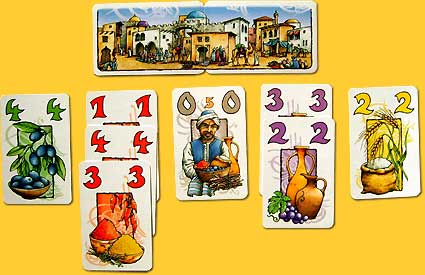 |
||||||||||||||||||||||||||||||||||||||||||||||||||
| x | |||||||||||||||||||||||||||||||||||||||||||||||||||
 |
Cavum | ||||||||||||||||||||||||||||||||||||||||||||||||||
| 03.11.08 The right combination in jewels and the most points, that is what it is about in this game. To get these jewels, players must make connecting routes to the beds that they place themselves, preferably far away from other players, as a player does not like to share his discovery with others. To make his point even more clear, even dynamite is used to blow up competitive routes! Once a round, on a route between two own mining stations, per bed a jewel may be taken; the jewels are used to make jewelry at the end of each round. The jewelry are cards that bring various points - up to 27, dependent on the number of jewels used, from two to four. There is a central bed on which yellow jewels can be taken, a little trick to force players to build towards the center of the board. The game ends after three rounds, but a round can last a while as each player wants to maximise his move, and besides this he may take from one to four actions, where placing a tile is one action. This makes a player prudent: he does not want to play a certain tile, as it would alarm the other players in its intention. On the other hand, if there is a single jewel left on a bed, a player will want to be the first one to take the prospect action. It is this that makes the players brains crackle, and the dreaded analysis paralysis lies in wait that lengthens the game. When building over an already built tile, competing routes can be blocked, so there are more subtle ways to block another players route than dynamite! A first play with two players lasted one and a half hour, during which the phrase 'The game can be played more sharp' repeatedly could be heard, as a player discovered some new nastiness in the game and immediately put it into practise! Despite the fact that 'Cavum' in fact is an abstract game, it captivated us like a good movie. And as with each good movie, when the closing credits appear, you feel like: 'What? Is it over yet?' Cavum, Wolfgang Kramer & Michael Kiesling, Hutter Trade / QWG, 2008 - 2 to 4 players, 12 years and up, 120 minutesxxtopxx |
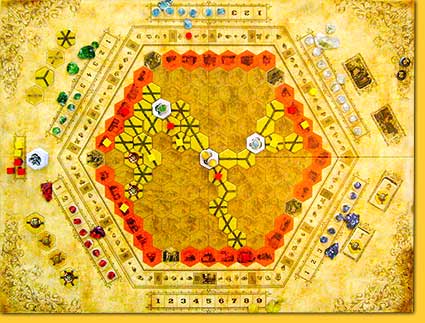 |
||||||||||||||||||||||||||||||||||||||||||||||||||
| x | |||||||||||||||||||||||||||||||||||||||||||||||||||
 |
Change Horses | ||||||||||||||||||||||||||||||||||||||||||||||||||
| 01.05.08 A racing game with horses; it has been done before. Only in this game the end condition has been changed; not the first, but the last positioned horse will win. Each player blindly is dealt a horse card; this is the horse he must try to keep behind. The horses are moved with cards; on each of the cards two colours are shown. Each of the players have their own set of horse cards at their disposal of which they initially choose three; these are simultaneously turned face up. In the first half of a round, two of these are played one by one in player order and placed on the center of the board, after which two new cards are chosen, turned face up, and two more cards of the three cards displayed are played. After this a round has ended and the horses are moved: all horses move that a colour has been played for, but only if there is an uneven number of cards of that colour, otherwise the horse does not move. Each player also has two special cards he may use during a race: cover one of the already played cards, or place a horse in an other lane in such a way that it blocks another horse that in this way cannot move, preferably the horse he is owner of. in the worst case, he may use the special card to draw a new owner card, and in fact changing horses, hence the name of the game. The game ends when one of the horses crosses the finish line; the owner of the horse that is on the last position has won. That is all, and all we need to play. But it is not much for a game published in 2008, especially if this game originates from a publisher who normally has the somewhat 'heavier' games in his program. The game is a stranger, as it is not supported by any other games in the program; it is like Ravensburger is putting 'Advanced Squad Leader' between its puzzles. The theme also is very well mannered and very seventies ('Jockey' from Ravensburger, 'Win, Place & Show' from Avalon Hill) although the old fashioned looking cover illustration has its charm. The synthetic horses are very fragile; a clumsy move made two of them fall in pieces on the floor. This leads to asking the publisher: change horses? Change Horses, Bruce Whitehill, Eggertspiele, 2008 - 2 to 5 players, 8 years and up, 30 minutesxxtopxx |
 |
||||||||||||||||||||||||||||||||||||||||||||||||||
| x | |||||||||||||||||||||||||||||||||||||||||||||||||||
 |
Batavia | ||||||||||||||||||||||||||||||||||||||||||||||||||
| 10.04.08 Five sailing nations among which Holland have grounded a trading company to sail to the East and take back all kinds of exotic goods. The Dutch 'Verenigde Oostindische Compagnie' (United East Indian Company), grounded in Amsterdam in 1602, widely is regarded as the largest, most succesful and best organised. The VOC had dozens of trading posts in Asia which all had their own trading network. During the half of the 18th century more than 20.000 people worked for the VOC in Asia alone. Although ruled by an Amsterdam board of trades men, in fact the VOC acted independently as a government on their own, started wars if necessary - Portugal was a hefty trading opponent, and also it had its own local administration of justice and fiscal system. The city of Batavia was the rendez-vous of the VOC, the central spot of the trading network in Asia. The players all follow the same route along the coast, visiting various trading posts where they collect their goods and take representation in the offices. To have a majority in these offices earns gold, necessary for winning the game. The ships, strangely represented by merchants, are moved by means of ship cards that first are auctioned. A die determines how many cards are auctioned, all in one set. The pplayer who wins the auction, divides his bid among the other players - it is a closed money system. Furthermore he becomes starting player and is the first who may play cards to move his merchant. Played cards stay in front of the player; when a player has a majority in played cards for a nation he gets the corresponding company seal, a wooden disc. This majority is a requisite to move the merchant: to the first trading post tile of that nation. On this tile also a good is depicted: either cotton, silk, pepper, china ware, nutmeg or ginger; the player places a crate in the corresponding office. In these offices majorities earn gold, but to play for a specific office a player must have the necessary cards. After the first player made his move, all other players have their turn: play cards and get (or already have) a majority of ship cards for one or more nations, move the merchant to the corresponding tile and place a crate. Alternatively, when a player is not able to achieve a majority, he takes two ship cards from the blind stack. The trading post tile where the merchant has landed goes to the player who can trade this in for gold immediately or keep it and save more for more gold. Five tiles earn fifteen gold, and this must not be confused with the money the auctions are done - gold is merely points. There is a twist when trading in tiles: a player may only trade in one or more tiles if the tile he just has acquired is of a nation he does not already have in his possesion - this way players who wait too long are stuck with tiles they cannot exchange for points. On a separate arch the score is kept how many cards are played by nation, and, by means of a cannon, in total. If, after a player has made his turn, this total reaches or exceeds a predetermined total, imaginary pirates rob all the cards of the nation of which the most cards are on the table, so all players have to discard these. This way the next player in line can easily achieve a majority by merely playing one card of a nation! When a player has reached the last tile, the game ends with the scoring in the offices. The player with the most gold has won the game. 'Batavia' has a pleasant look and plays accordingly. Despite several known mechanisms it is a playful game that has the right balance and feels original. Will it bring the coronation for Queen this year? Batavia, Dan Glimne & Grzegorz Rejchtman, Queen Games, 2008 - 3 to 5 spelers, 10 years and up, 45-60 minutesxxtop |
|
||||||||||||||||||||||||||||||||||||||||||||||||||
| x | |||||||||||||||||||||||||||||||||||||||||||||||||||
 |
Chicago Poker | ||||||||||||||||||||||||||||||||||||||||||||||||||
| 24.12.07 Chicago, 1920: several infamous gangster bosses are enjoying a friendly game of poker. The stakes: several lucrative business establishments in four different categories, namely jazz-clubs, bars, breweries and gambling houses. We are playing with a deck composed of the numbers 1 to 15 in five colours, and some additional action cards. In your turn you must perform three actions, and you can choose from taking a card and playing a card. Two to four shops are open on the table. When you play a card, you can place it next to any of the shops. This way, you can slowly build up a poker hand at each of the shops: straight flush, four of a kind or full house, it will sound very familiar to the die-hard poker player. As soon as a player places his fifth card at one of the shops, his hand is considered complete: a wooden bullet is placed on his cards. At the beginning of his next turn, the cards that all players placed next to this shop are compared, and the player with the most valuable hand wins the shop. One complication is that some cards are played face-down, depending on the type of shop. For example, at a brewery all cards are played face-up, while at a gambling house they’re alternatingly played face-up and face-down. You can use these face-down cards to suggest a terrific hand that you don’t have, in other words, bluff! The first player to win a certain number of shops wins the game. The poker variant Chicago Poker is less strategic than ‘real’ poker because of the unpredictable influence of the action cards (liquidations, razzias, bribery), and it’s easier because you can work on multiple poker hands simultaneously: every card you draw is bound to be useful for at least one of the shops! The illustrations on the cards nicely capture the atmosphere of Chicago in the 1920s, they look a lot more attractive than your average Jack of Spades, but nonetheless, everybody who enjoys poker will probably prefer actual poker, and everybody who doesn’t like poker won’t really like Chicago Poker either. The added value of this game therefore is very limited. Barbara van Vugt Chicago Poker, Bruno Cathala & Bruno Faidutti, Phalanx Games, 2007 - 2 to 6 players, 10 years and up, 45 minutesxxtopxx |
|
||||||||||||||||||||||||||||||||||||||||||||||||||
| x | |||||||||||||||||||||||||||||||||||||||||||||||||||
 |
Auf Achse | ||||||||||||||||||||||||||||||||||||||||||||||||||
| 14.11.07 Yes, there is a die involved, two even! And no: it is not an innovative game, even more because it is a reissue from the original from 1987. But is it a nice game? Yes! ‘Auf Achse’ (meaning: on axles) was quite justly awarded ‘Spiel des Jahres’ in 1987, and has stayed a very popular game throughout the years. On a map of Germany and some bordering areas is an overlay of highways that connect the most important cities, from Rotterdam to Trieste, and from Geneva to Rostock. These cities have to be supplied, and the two to six players will take care of this. The players already have the first three of their freight orders in their hands; the remaining orders come from a blind deck from which the first four always are shown. The card shows where the goods must be picked up, and where they have to be delivered. Also depicted are the revenues, and the amount of cargo. The order ‘Hannover-Stuttgart’ brings in 2800 Euro for four parcels. The throw of a die moves the truck; fortunately two dice may be used from which one may be chosen. The following considerations have to be made: when a player ends in a city while using the full number of one die - this does not need to be his end destination – he may try to acquire a new freight order by choosing one of the four open cards and letting the other players bd for it. If there is no bid, he may take the order for free. If there are other bids, he has to match the highest bid in order to get the order; otherwise the card goes to the player with the highest bid. The bids must be increased by a set amount shown on the freight order card; these bids may vary per freight order card. This means that the revenues for a freight order has reduction from the amount of the bid as initial costs. A new freight order immediately is taken from the blind stack that has a varying amount of cards, dependent from the amount of players. When a player lands on a space with a traffic information sign, he takes a card from the corresponding stack that acts as a ‘chance’, and performs the action on it. Most of these cards have a postive effect, such as the card ‘subcontractor’: ‘A collegue assists you with the execution of a larger freight order. You and a player of your choice may move up to three spaces.’ Or a card such as this one, that you may keep until needed: ‘When in Frankfurt, you may perform an air freight order. Unload you freight and collect the revenue for it. The air freight costs are 500 Euro.’ Apart from this there is a road block, and a traffic jam marker that can be placed to hinder movement, for other players, of course! A freight order may bring a player in the vicinity of an other order, and it is obvious, or at least tempting to qualify for that order as well, and accept the detour. The loading capacity of a truck is limited to 6 parcels, but an unlimited amount of trailer wagons can be bought, offering space for four or six parcels per trailer. When players have acquired all the freight orders from the deck, play ends immediately when a player has performed all his orders; after that the player with the most money wins. ‘Auf Achse’ did not lose anything from its charm, and even has been repolished and dyed: a new map with a more contemporary background and ditto network of roads, new graphics for the freight orders and ‘chance’ cards, and even the ‘Brummi’s’, as the German nickname the trucks, apparently come from an up to date wind tunnel - well, O.K., this last fact is a bit exaggerated! The rules have undergone some editing and deliver more flexibility and smoother gameplay: a choice for movement from two dice instead of one die, no unwanted blocking in movement, and disposal of ‘unwanted’ freight orders; all this keeping the game length well under an hour. The player who then has managed to drive the most economical, stands a good chance of winning! For runners up who have kept the necessary vehicular gap, unfortunately no bonuses are given - but on the other hand no tickets for those who didn’t! Auf Achse, Wolfgang Kramer, Schmidt Spiele, 2007 - 3 to 6 players, 8 years (simplified rules) and up (normal rules), 45 to 60 minutesxxtopxx |
|
||||||||||||||||||||||||||||||||||||||||||||||||||
| x | |||||||||||||||||||||||||||||||||||||||||||||||||||
 |
Container | ||||||||||||||||||||||||||||||||||||||||||||||||||
| 11.11.07 Shipping containers, and collecting money for it, it’s as simple as that! Each player has his own player board, on which the production units are placed; the first is free. Each unit produces one good, if this has been chosen as one of the two actions in a turn. The produced good, neatly packed in a container of the same colour, are offered for sale; the player decides for what price by placing it in the corresponding space on his board. Every other player may buy these containers for the labelled prices; the active player buys these from other players for one action per player and places them subsequently, curiously enough without the need of a transporting ship, on the docks of his harbour. The capacity is dependent on the amount of his warehouses which purchase again is one of the actions a player can take in a turn. Well, we have produced, we have bought, we have goods in the docks, all is set for shipping our goods! Unfortunately we cannot ship our own goods; this must be done by other players; so, we ourselves take our ship and set for other players boards too , with an in between turn/action at open sea: the space on the table between the player boards. At the destination harbour we at last are able, as one of the two actions, to load the containers. Payments must be made for the corresponding prices of the containers. Well then, may we now...? We are nearly there, but not quite! The ship must, as one of its actions, be moved to open sea, and with a second action it may enter the harbour of the central island. This island looks like a pirates nest, where for each player an outlined site is reserved. So, unloading may begin! But wait: you are not allowed to unload your containers just by that (What are you talking about? I just bought them, and you say I may not just put them in my lot?!), but have to change ownership in a blind bid! All other players but the player with the container ship may bid, and the highest bidder gets the containers and places them in his lot. The active player may take the goods himself by paying the highest bid to the bank. If, however, he accepts the highest bid, he gets the money from that player, plus the same amount from the bank as a sort of state allowance. The game ends when two of the five container types from the stock have depleted; then all containers at the island are valued according to a player card that is somewhat different for each player; finally the player with the most money wins. So? What do we think of it? Well: quite a hassle to make out of a simple thing something very constructed and needlessly complicated. And why? Each player has his products that he offers for a competing price. That means he cannot deviate too much from what other players have set; the levelling influence of the competition is unmistakenly present. So: what are we doing it for, and what is the difference? Where lies the pleasure of the game? Is it the plastic ships, that gives us our little pleasure? Because for everything else, the game is dry taste and very repetitive, offering very little, be it atmosphere or tension, but one that takes forever. In the meantime we are playing amidst the malicious and possible poisonous vapours of the Chinese manufacturer! It is a pity we must come to this conclusion, but this game is not the expected magnum opus... Container, Franz-Benno Delonge & Thomas Ewert, Valley Games, 2007 - 3 to 5 players, no indication on age (suggested: 12 years and up), 90 minutesxxtopxx |
|
||||||||||||||||||||||||||||||||||||||||||||||||||
| x | |||||||||||||||||||||||||||||||||||||||||||||||||||
 |
Before the Wind | ||||||||||||||||||||||||||||||||||||||||||||||||||
| 15.07.07 It seems as if Phalanx has proclaimed 2007 as Nautical Year! Anyhowway, in ‘Before the Wind’ we stand out to sea again, well, the ships in the harbour as we ourselves are mainly busy acquiring goods and shipping them. Players start with an empty warehouse and some money. The starting player turns as many cards as there are players from two to three decks: goods, store, and shipping. From these, he chooses a card; after him all players choose one. This looks like a starting player advantage, but the bidding mechanism, which has a slight resemblance of the one used in ‘Edel, Stein & Reich’ allows a player to bid for a card that a player before him has chosen instead of taking one of the other cards. This is a one time bid, and the owner of the card decides if he accepts it, handing over the card for the money, or pays the bidding player the amount and keeping the card. This way nasty and hostile take-overs can take place! So, when deciding which card to take a player not only has to consider what card to choose, but also if there is a chance that another player also wants it and will make a bid for it. And if there is a bid, does he want to keep the card - and does he have sufficient money to pay for the bid? On the other hand, a player could choose a card he knows another player will certainly bid on if his only purpose is to make money! After each player has chosen a card, or has received money for it, the action on the cards are executed: take good (cards) in your hand, store goods in your warehouse, or ship. The goods in a players hand move to the warehouse in a later round if a store card is acquired. The warehouse has a storage capacity for up to eight goods. With a shipping card goods can be shipped from the warehouse to one of the ships that wait in the harbour; each ship takes from one to four goods that have to be shipped in order to acquire the ship card - and the points depicted on it. In the beginning of a game, the goods cards are more attractive than the store cards. The shipping cards have a double function; with these a player either can deliver goods from his warehouse to a ship, or he can take the amount of money depicted on the card. This makes it even more awkward to choose between the cards: a player may want to take the shipping card and use it for shipping, but the same card will be attractive to any player in need for money, so if there is a bidding, however small the bid will be, the money must be at hand. As a tactic, a starting player in such a situation will turn two shipping cards open and take the one with the lesser amount of money on it, leaving the higher amount for the player short of cash. When there are only two ship cards left, these last two also ‘sail away’, and are removed from play, after which a new set of ships is laid out. Bad luck for the players with goods cards in their hands, as all of these have to be discarded. From the warehouse half of a players spice and cheese may be kept, but all fruit rots away; silk however is unharmed. When a player has collected the necessary amount of points (ship cards), the game ends after which the player with the highest score has won. ‘Before the Wind’ ofcourse just is an auction and collecting card game, but the little changes in the bidding mechanism, and other small things such as the double function of the shipping cards make it a vicious and exciting little game, and a nice and justified addition to the game menu! Before the Wind, Torsten Landsvogt, Phalanx Games, 2007 - 2 to 4 players, 10 years and up, 75 minutesxxtop |
|
||||||||||||||||||||||||||||||||||||||||||||||||||
| x | |||||||||||||||||||||||||||||||||||||||||||||||||||
 |
Anno 1701 - Das Kartenspiel | ||||||||||||||||||||||||||||||||||||||||||||||||||
| 08.07.07 People like more of the same out of a habit; they do not like changes as a rule. We encounter this in many appearances, such as music enthousiasts who collect all music by one single artist, of course because the music attracts them, but also because it is convenient. Why would one search any further, while what you like is right at your feet? It makes life so much easier, as we all are born tired. And convenient it is, when your bus arrives exactly on time and on the spot. Taking an other bus for a change and just for fun will not appeal to anyone with which the appointment was made somewhere else in the city. It might be a nice surrealistic action, but one would end up with no friends at all, or just those who also take a random bus and arrive at your doorstep just by chance. Nah, certainty, that is what we actually want; the familiar Hackbraten (meatloaf) and not this odd couscous. It is not strange therefore that ‘Anno 1701 - Das Kartenspiel’ plays along known shores: the shoreline that we know from the first Settlers card game. Players instantly know what they take in: ‘The Settlers - Catan Card Game’, topped with a not too exotic sauce. ‘Anno 1701’ has its origin in the in Germany very popular computer game ‘Anno 1602’ from 1998, where, as in Civilization but on a smaller scale, a community has to reach its full growth. In the card game, pioneers have to climb the social ladder to become, via citizen, a well respected merchant; with two of them winning the game. Trading with other islands is inevitable and desirable as only through acquirement of the exotic tabacco and rum the status can be upgraded. The community also has its own wishes regarding Kneipe (bar), church or community centre, and their happiness or dissatisfaction is rewarded or punished by an occasional die roll. In ‘Anno 1701’ all these elements are used and mixed with the mechanism of the ‘basic’ Settlers card game. Players now need gold to buy rum and tabacco, and do this by sending ships on expeditions that may encounter hazards such as hurricanes or pirates. But if they manage to overcome the pirates, they get a reward. This ship expedition is a mechanism directly borrowed from ‘The Starfarers of Catan’. Everything works, and feels familiar. But why does it not appeal, then? ‘The Starfarers of Catan’ and ‘The Settlers - Catan Card Game’ were nice to play, although the following variants brought their wear and tear. The original ‘The Settlers of Catan’ was a very nice game and it justly was awarded ‘Spiel des Jahres’ in 1995. But gradually other questions arise: is a game with a playing time of one and a half, two hours, not a bit too long? Also we need a LOT of table space for the cards; we consider ourselves fortunate that we have a large table, but not everyone will have the necessary 80 x 90 cm table space available to place all the cards in the course of a game (in the alongside illustration the set up is shown, taking the space for the to be placed cards into account). Even more: would a game with such a game length, material and complexity make it into print nowadays if it would come from an unknown and starting author? Also frustrating is one of the victory conditions, that states that a player has won when the other player has run out of gold in both of his community centres. This feels very unsatisfying, and if it happens to you this is not because of mismanagement but because this is deliberatley put into the game by means of events that make you lose gold. And then one players has won, because the other has lost! The illustrations of the buildings are nicely done. These are computer generated pictures, and there already seems to be an ‘Anno 1701’ computer game. This brings us back to the original ‘Anno 1602’, but compared to the latter ‘Anno 1701’ will surely be a pale extract. After ten years, the magic of the revolutionary ‘Settlers’ game has been exhausted. This brings up the question: is it not about time for a new revolution, a new concept? So, although we do not like changes that much, the bus route itself may change from time to time, and we do not mind if we are driven by the same or another driver, if only he keeps a steady eye on the road. This gives us something new to experience during the journey to our fixed destination! All in all, the 1701st Variant of Catan has too little aboard to captivate us... Anno 1701 - Das Kartenspiel, Klaus Teuber, Kosmos, 2007 - 2 players, 10 years and up, 60 minutesxxtop |
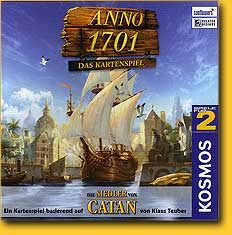 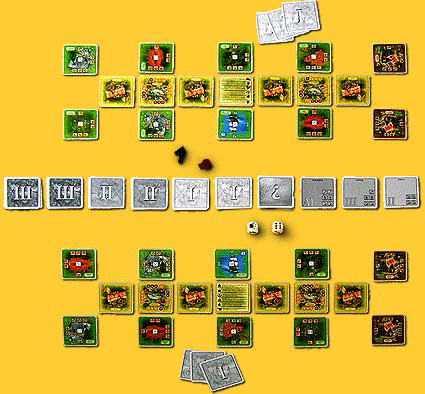 |
||||||||||||||||||||||||||||||||||||||||||||||||||
| x | |||||||||||||||||||||||||||||||||||||||||||||||||||
 |
Balam | ||||||||||||||||||||||||||||||||||||||||||||||||||
| 30.05.07 You know that old Maja-song: produce goods and build a kingdom. In Balam the players each represent an ancient Maja-king, who produces goods in his village that, at the end of a turn, are transported to his buildings for further use. Goods sacrificed in the temple earn victory points, whereas goods transported to his palace can be moved to the player’s stock. Direct storage of goods in a barn is also possible, and some goods can be put up as guards in his garrisons. Apart from these buildings, it is also possible to build a pelota stadium, the favourite sport of the Maja's, for additional scoring during one of the annual pelota tournaments. Constructing a building is not free; except the construction costs there is also a tax which must be paid. When a player cannot afford or doesn’t want to pay the tax, he must turn over one of the Katun cards. This event card takes effect immediately. At the beginning of the game these event cards are all positive events such as `good harvest’, giving all players extra wheat, or 'return of an expedition ', with 2 extra jade for the active player. Later in the game the cards from the deck contain many disasters. These are rather harsh, especially when a volcano is erupting thereby destroying several of a player’s buildings. Due to these disasters the game can get rather unbalanced. If a player is unlucky he draws only disasters and not any positive event. However, a ransom can be paid to avoid these disasters, but this is dependant if a player has the correct goods in stock. Paying ransom is an expensive matter, and frequently requires sacrifying prisoners of war. Prisoners are taken after a successful attack on an another player. Where possible a player should attack to keep the prisoners file up to the mark. The attacks are resolved using dice, again leaving ample room for bad luck. The mix of mechanics of building, transporting, event cards and prisoners however creates a nice blend of luck and strategy and works rather well. This certainly will not be every players opinion at the end of a game; some players will feel disappointed by the number of disproportionately hard disasters they encountered. Being a home produced game, the quality of the components is excellent and the graphics are top notch. Marijn Vis Balam, Patrice Vernet, Neuroludique, 2006 - 2 to 4 players, 90-150 minutesxxtop |
|
||||||||||||||||||||||||||||||||||||||||||||||||||
| x | |||||||||||||||||||||||||||||||||||||||||||||||||||
 |
Colosseum | xx | |||||||||||||||||||||||||||||||||||||||||||||||||
| 08.04.07 Being a Roman impressario sets a heavy task to oneself: take care behind the leave strip that everything is in perfect order: did I book my arena and does it have enough capacity, do I succeed in persuading the stars to perform in my program, and do I manage to attract enough visitors, possibly added with the undivided attention of the local notableness? We have five times to measure our popularity with our fellow captains of entertainment, after that the one that managed to attract the most audience has won. We start with a modest program that we got at the start of the game; each player also has some artists or animals under contract. At the local entertainment fair we can try to contract more of these gifted performers or animals, that come in sets of four and are bought by auction. If we have some undesirable components we can trade these against any condition, but after the trade we must execute the program, complete or not. When we give a complete show, we get the full points/audience for it, for every artist that did not show up points are subtracted, how much of the audience remains can be seen on our program so we know in advance what the consequences are. The frustration and possible venomousness of the game lies in the fact that we are only allowed to make one action at the start of a round, actions that we as an impressario feel that we would like to do more of them, two, or even three! This includes the purchase of a new and larger show, or extending the arena, as larger shows require more space and atract more people, otherwise because of security reasons the fire brigade may call the whole thing off! Each active player moves a notable (senator, consul or the emperor); if he manages to move it into his arena it earns him more spectators. At the end of a round the player who attracted the most people with his show gets a podium, type sky box, that adds a fixed amount of 3 spectators with each following show in his arena, but the little disadvantage of the advantage of having scored best is that the player who is most behind in points/spectators may snatch away one of the artists from this player; in old Rome games did not quite go honestly either! And there are more little extras, bonuses and additions that add to the game and make it a very enjoyable and playable game with a rather low entry level. It has a very nice atmosphere, not in the least because of the detailed illustrations in bright colours, but overall because of the wonderful notable tokens. Further it is a delight to see how every part has its own space in the game box. Days of Wonder has done more than just publishing a game; it once more has made a statement: that there is a market for games with wealthy execution and superfluous components. Colosseum, Wolfgang Kramer & Markus Lübke, Days of Wonder, 2007 - 3 to 5 players, 10 years and up, 60 to 90 minutesxxtop |
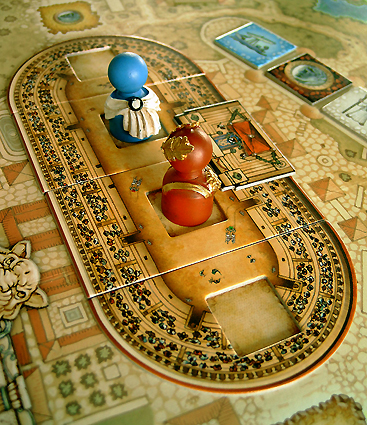 |
||||||||||||||||||||||||||||||||||||||||||||||||||
| x | |||||||||||||||||||||||||||||||||||||||||||||||||||
 |
Die Baumeister von Arkadia | ||||||||||||||||||||||||||||||||||||||||||||||||||
| 26.11.06 Pick up your cement tub, because it's building time once again! This time our journey leads us to Arkadia, with its gentle slopes and fertile valleys. It is here that a city must be erected, with a massive castle as its central master piece. At the same time this palace triggers the payment of the surrounding buildings, and the player that has gathered most of it by game end wins. At the start of the game each player is dealt four building cards, on which buildings of varying size and colour are depicted, one on each card. They also get three workers in their player colour that they put behind their player screen. In a turn, a player decides wether to play a card or to place one or more workers adjacent to any single building. When playing a card, he places the building tile onto the board adjacent to any other tile or the castle building ground, and he puts a seal on it that matches the colour of the played card. It doesn't get tougher than this. When a building is completely surrounded by other buildings and/or workers, it gets scored and every player that has a worker in his colour next to it, gets a seal in the same colour of that on the building. The player that triggered the scoring gets the seal on the building as a bonus. After this he has to place a palace piece; during the first phase of the game he is only allowed build at level one high, during the second he builds on the second level, and in the last phase each player may only build one final palace piece on the third level. There are only so much pieces per phase in the stock, and from each of the first two phases two pieces remain that get transferred to the stock of the last phase. Each palace piece has a coloured seal showing on the roof. When a player takes an extra action and hands in one of the four streamers that he got at game start, he gets two additional workers. Apart from this, he may cash for the collected seals against the daily rate: the number of seals visible on the roofs of the castle, multiplied by the collected seals of that colour. The scarce workers can be added with a neutral one that may be taken for each preprinted tent that gets covered when placing a building tile. It may not seem much, but this way it helps to handle the scarce resources that laborers are. It might even be better to surround a building with another building, just to save workers. The scoring might be less, but at least the player still has ammunition to score at an addtional spot. When one player has collected many seals of one colour, other players surely will cover that palace seal and place one of an other colour more favorable to them. When the second level of the palace is completed, each player has one final turn in which he could place a thrid level palace piece. Everything in this game looks just fantastic! The atmosphere is great, choices are simple with the neccessary tactics, it plays swift, and tastes for more. Ravensburger has made a great game for us (spoiled) gamers once again. And you know what: it feels Chinese Dam good! Die Baumeister von Arkadia, Rüdiger Dorn, Ravensburger, 2006 - 2 to 4 players, 10 years and up, 45 to 60 minutesxxtop |
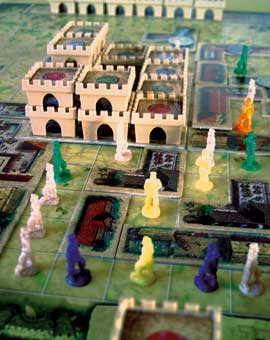 |
||||||||||||||||||||||||||||||||||||||||||||||||||
| x | |||||||||||||||||||||||||||||||||||||||||||||||||||
 |
Anasazi | ||||||||||||||||||||||||||||||||||||||||||||||||||
| 20.10.06 We learn a lot, all together. The game manufacturers not only draw from the never drying well of the romance of Knighthood or the Antiques, but occasionally they also give us something, not to play with, but to reflect, as this lesson of American Heritage we are tought in the intro text. Behind the slightly tongue breaking title that might end up with 'anaesthesia' goes an Indian tribe that lived in caves of the canyons in the Midwest of America. By the end of the nineteenth century these sometimes wellpreserved settlements were discovered, some of them made up of up to hundreds of rooms, with signal towers to communicate with some of the wider spread groups. In the game the canyon parts are laid out on the table; the starting positions are placed behind the outer ring. Each of the players may try to reach any of the settlements with their ladders, in which a treasure in one of the four possible colours can be collected. A maximum of two ladders may be placed, and a treasure only may be collected when a ladder exceeds the contours of the settlement. Some of the settlements have towers, they can but must not be collected. Each of the towers has a colour underneath; if collected they are placed on the score track of that colour where they decrease the value of all collected cubes in that colour by one. At the start of the game each player has been blindly dealt a card that doubles the value of one colour; so collecting these is strongly advised. When the stock of ladders is depleted, all players calculate their total and the winner is taken on the shoulders and carried through the room, at least in our culture! Because of the placement rules, the conditions for collecting cubes, and the material itself, the game has a high Mikado feel: 'Nope, you do not cross the border by just a hair!' 'Oops!' 'Now you moved the chain!' 'Shall I just take the cube now, then?' The Anasazi itself were just an agricultural tribe, learns a quick Google search; no treasures everywhere! So if we are told a story, we'd not like to get a twisted one. On playing, we got visions of cane furniture, knitting work and profile sawing. All these are also part of a culture, but happily one that we left behind. We'd rather have a challenge in front of us; this game cannot qualify as such... Anasazi, Klaus-Jürgen Wrede, Phalanx Games , 2006 - 2 to 4 players, 10 years and up, 30 minutesxxtop |
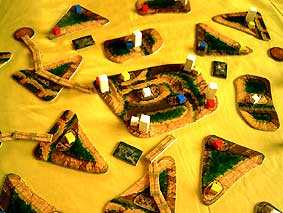 |
||||||||||||||||||||||||||||||||||||||||||||||||||
| x | |||||||||||||||||||||||||||||||||||||||||||||||||||
| x | |||||||||||||||||||||||||||||||||||||||||||||||||||
| x | |||||||||||||||||||||||||||||||||||||||||||||||||||
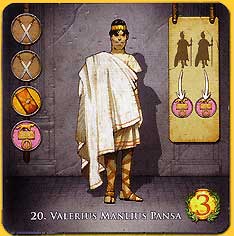
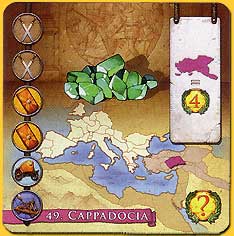
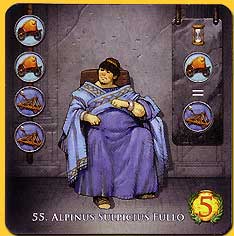
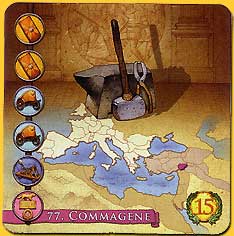
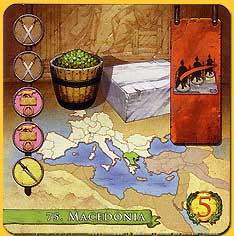
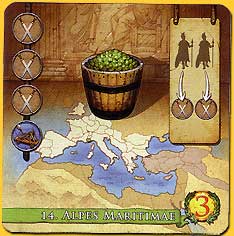
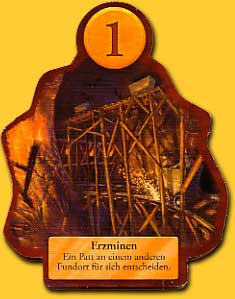
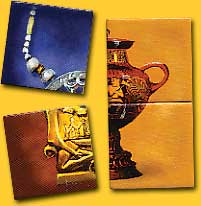
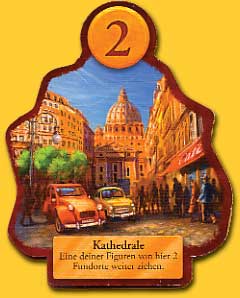

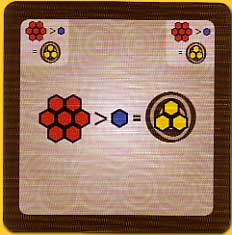
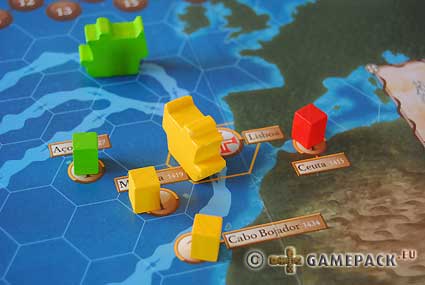
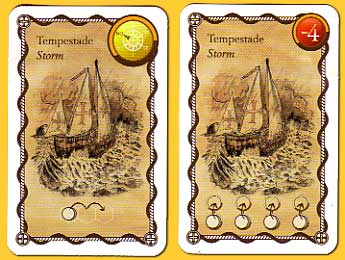
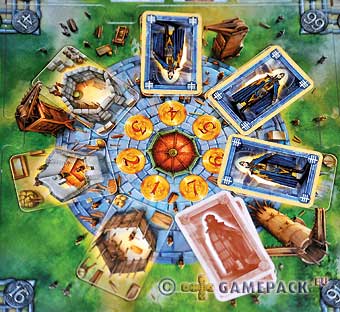
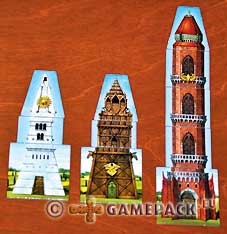
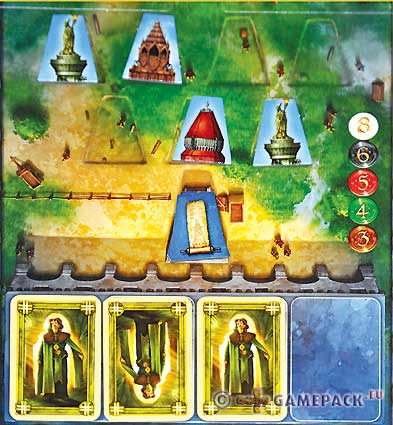
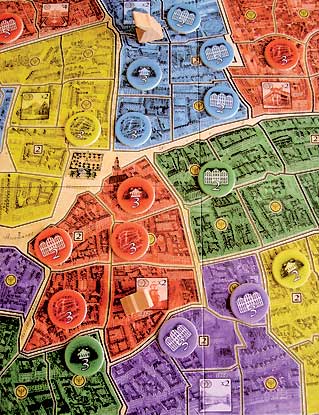
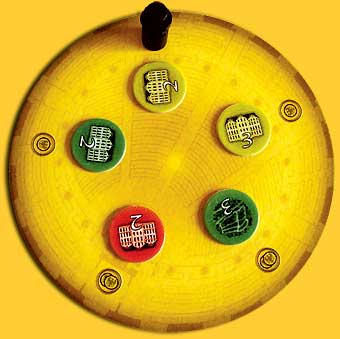
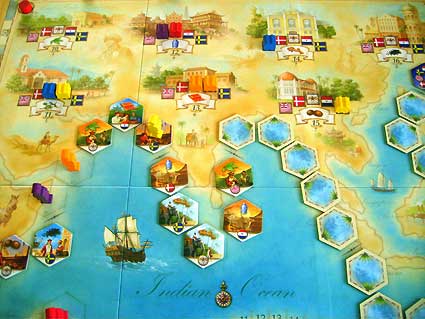


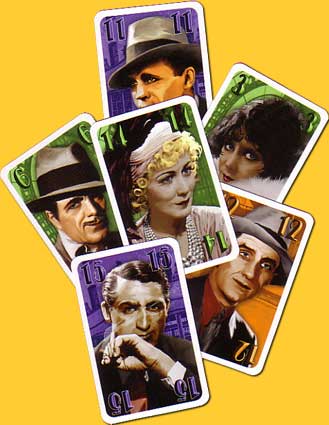
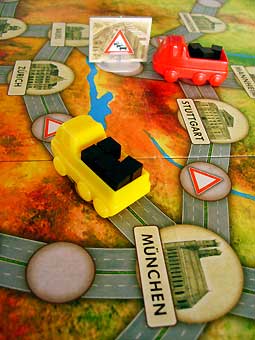 xx
xx